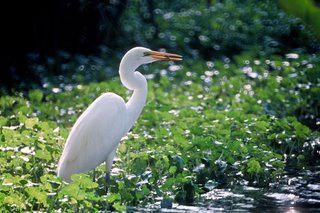Difficult decisions in Pennsylvania
 What do you do when one species begins to encroach on the nesting habitat of two at-risk species? That dilemma has faced wildlife officials in Pennsylvania for almost 10 years. This week, the Pennsylvania Game Commission announced its "long-considered, last-resort option" to kill Double-crested Cormorants nesting on Wade Island, an Important Bird Area and a long-time nesting site for Great Egrets (above) and Black-crowned Night-Herons.
What do you do when one species begins to encroach on the nesting habitat of two at-risk species? That dilemma has faced wildlife officials in Pennsylvania for almost 10 years. This week, the Pennsylvania Game Commission announced its "long-considered, last-resort option" to kill Double-crested Cormorants nesting on Wade Island, an Important Bird Area and a long-time nesting site for Great Egrets (above) and Black-crowned Night-Herons."...no other place in the state comes close when comparing the number of nesting sites of these magnificent birds," said Dan Brauning, Game Commission Wildlife Diversity Section supervisor. "Unfortunately, Double-crested Cormorants - also colony nesters - have invaded the night-heron and egret nesting area, and the nesting activity of the cormorants has increasingly become a concern. While cormorants were at one time rare in Pennsylvania, populations have steadily increased since the early 1980s, and they have never been considered a candidate for the state's species of concern list."Brauning said studies show that when nesting cormorants encroach upon colonies of other nesting birds, they reduce the amount of nesting space for those species. Cormorants have been known to take over egret nests and to kill trees as a result of their nesting activity. Several cases found that cormorant droppings on nesting trees apparently caused egrets to abandon colonies.
"In addition to the competition for nesting sites, cormorants also may compete with the herons and egrets for food in the local area around Wade Island," Brauning said. "All three birds feed on fish, and while cormorants usually dive deeper than herons and egrets for their food, scientists believe that the feeding areas of the three species likely overlap in the shallow depths of the Susquehanna River."The commission has worked with USDA Wildlife Services and U.S. Fish & Wildlife Service to plan the culling program.
It's a difficult situation... or maybe it isn't, in your view. How would you handle the cormorants' effect on the egrets and night-herons?
Great Egret courtesy of U.S. Fish & Wildlife Service


0 Comments:
Post a Comment
<< Home